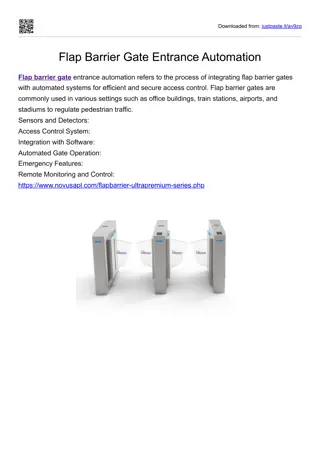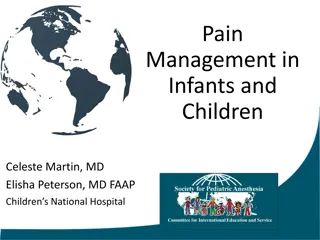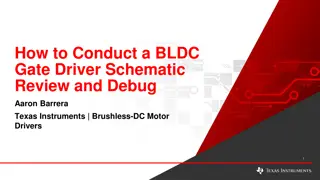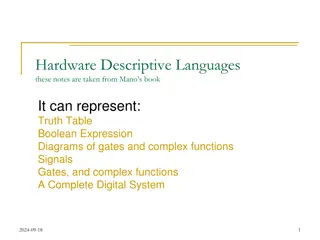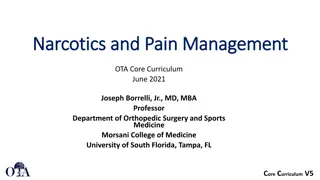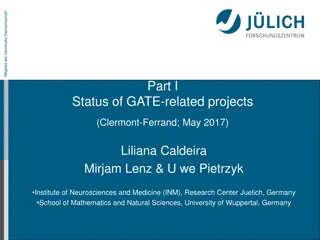Understanding the Gate Control Theory of Pain in Pain Management
This detailed content delves into the Gate Control Theory of Pain, explaining pain pathways involving nociceptors, A-delta fibers, and C fibers. It further explores central pain pathways like the spinothalamic tract, spinomesencephalic tract, and spinoreticular tract. The theory's mechanism of pain control through ascending and descending pathways is also discussed, illustrating how rubbing the painful area can alleviate pain. Developed by Melzack and Wall in 1965, this theory offers insights into pain modulation and management strategies.
Download Presentation

Please find below an Image/Link to download the presentation.
The content on the website is provided AS IS for your information and personal use only. It may not be sold, licensed, or shared on other websites without obtaining consent from the author. Download presentation by click this link. If you encounter any issues during the download, it is possible that the publisher has removed the file from their server.
E N D
Presentation Transcript
GATE CONTROL THEORY OF PAIN AAKANKSHA BAJPAI ASSISTANT PROFESSOR SCHOOL OF HEALTH SCIENCES
PAIN PATHWAYS Peripheral Pain Pathways Nociceptors (also called pain receptors) are free, noncorpuscular nerve endings of A-delta and C fibers that conduct nerve impulses toward the central nervous system. They are found in the skin, muscle, joints, bone, and viscera and have a high threshold for activation. This threshold is lowered by release of chemical substances after tissue injury and inflammation. These chemical substances include prostaglandins, bradykinin, histamine, acetylcholine, potassium ions, substance P, calcitonin generelated peptide, serotonin (5-HT), nerve growth factor, thromboxane, acidic environment, leukotriene, and adenosine triphosphate. In other words, these substances sensitize the nerve endings.
A-delta fibers are thin myelinated fibers that respond to high-intensity mechanical and thermal stimuli. They are responsible for fast-conducting peripheral pain signals. The function of A-delta fibers is associated with the first pain sensation, precise location of noxious stimuli on the body, and generation of withdraw reflexes. The sensations associated with A-delta fiber activation are usually described as sharp, stabbing, or pricking. C fibers are unmyelinated and thin fibers that respond to a broad range of painful stimuli, including mechanical, thermal, or chemical. They are also called polymodal fibers, meaning that they respond to a variety of painful stimuli. The pain produced by activation of C fibers is considered second pain and characterized as slow, dull, aching, burning, and long lasting. C fibers generate second-pain sensation and are important to prevent further tissue damage.
Central Pain Pathways The spinothalamic tract (STT) is generally considered the main pathway responsible for transmitting nociceptive input from somatic and visceral tissue to higher centers. Most neurons of the STT cross the midline at the spinal cord level via the anterior white commissure to ascend to the ventroposterior lateral thalamic nucleus and medial thalamic nuclei. STT cells carry discriminative features of type and location of pain and respond to noxious thermal and mechanical stimuli. The spinomesencephalic tract ascends to the midbrain and terminates in periaqueductal gray (PAG). Spinomesencephalic cells terminating in the PAG may activate a descending inhibitory system that promotes analgesia due to the release of serotonin. The spinoreticular tract is constituted by cells that ascend to the medullary reticular formation and to the pontine reticular formation. Neurons of the spinoreticular tract allow for suppression or facilitation of pain and are involved in the motivational, emotional, and unpleasant components of pain.
The Gate Control Theory of pain control can be described in terms of ascending and descending parts. The classic example of the ascending mechanism is rubbing the painful area to reduce the pain for some injuries. The gate control theory was proposed in 1965 by Melzack and Wall and was modified in 1975 and 1982. They proposed a more complex interaction of peripheral and central mechanisms. Injury activates small-diameter myelinated afferent nerve fibers (A-delta fibers) and small-diameter unmyelinated afferent fibers (C fibers). These nerve impulses excite central transmission cells (T cells) that were proposed to be in the substantia gelatinosa of the dorsal horn of the spinal cord.
*Note- Tract cells: Second-order neurons of the pain and temperature pathways. The axons of these cells cross the midline of the spinal cord and ascend in the anterior lateral fasciculus. Tract cells are sometimes called T cells, but they should not be confused with the T cells of the immune system.
These T cells receive a convergence of excitatory and inhibitory influences, some from nociceptors and some from other sensory nerve endings. Whether further transmission occurs and the pain signal is sent on to higher centers to be perceived by the individual depends on the summation of inhibitory and excitatory influences. In addition, Melzack and Wall proposed that descending control from the brainstem and cortex also strongly influenced the excitability of the transmission cells. They stated that psychological factors such as past experience, attention, and emotion influence pain response and perception by acting on the gate control system.
ENDOGENOUS OPIATES The influence of the endogenous opiate system contributes to the higher centers descending mechanism of pain control. The hypothalamus can also control pain caused by prolonged intense stimulation. The hypothalamus controls the release of beta-endorphins from the pituitary gland. These powerful endogenous opiates then enter the bloodstream and circulate. This contribution results in strong inhibition of pain perception. Enkephalin is another endogenous opiate, triggered by the descending mechanism, originating in the raphe nucleus. The basic descending mechanism is that certain highercenter (brain) structures can facilitate the closing of the gate or inhibition of small-diameter afferent traffic through descending connections in the dorsal horn. The portions of the cerebral cortex responsible for emotion facilitate the periaqueductal gray region, starting a descending pain control mechanism. This portion of the descending mechanism is often referred to as central biasing.




